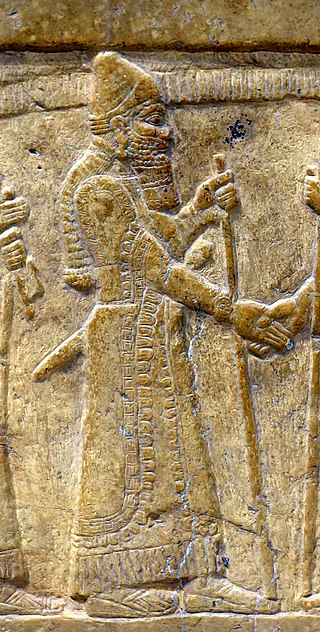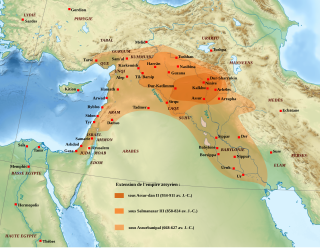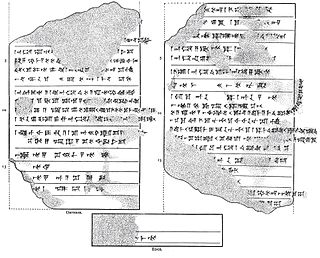Related Research Articles

Babylonia was an ancient Akkadian-speaking state and cultural area based in the city of Babylon in central-southern Mesopotamia. It emerged as an Amorite-ruled state c. 1894 BC. During the reign of Hammurabi and afterwards, Babylonia was called "the country of Akkad", a deliberate archaism in reference to the previous glory of the Akkadian Empire. It was often involved in rivalry with the older ethno-linguistically related state of Assyria in the north of Mesopotamia and Elam to the east in Ancient Iran. Babylonia briefly became the major power in the region after Hammurabi created a short-lived empire, succeeding the earlier Akkadian Empire, Third Dynasty of Ur, and Old Assyrian Empire. The Babylonian Empire rapidly fell apart after the death of Hammurabi and reverted to a small kingdom centered around the city of Babylon.

The Kassites were people of the ancient Near East, who controlled Babylonia after the fall of the Old Babylonian Empire c. 1531 BC and until c. 1155 BC.

Shamshi-Adad V was the King of Assyria from 824 to 811 BC. He was named after the god Adad, who is also known as Hadad.

Marduk-apla-iddina I, contemporarily written in cuneiform as 𒀭𒀫𒌓𒌉𒍑𒋧𒈾dAMAR.UTU-IBILA-SUM-na and meaning in Akkadian: "Marduk has given an heir", was the 34th Kassite king of Babylon ca. 1171–1159 BC. He was the son and successor of Melišipak, from whom he had previously received lands, as recorded on a kudurru, and he reigned for 13 years. His reign is contemporary with the Late Bronze Age collapse. He is sometime referred to as Merodach-Baladan I.
Aššūr-bēl-kala, inscribed maš-šur-EN-ka-la and meaning “Aššur is lord of all,” was the king of Assyria 1074/3–1056 BC, the 89th to appear on the Assyrian Kinglist. He was the son of Tukultī-apil-Ešarra I, succeeded his brother Ašarēd-apil-Ekur who had briefly preceded him, and he ruled for 18 years He was the last king of the Middle Assyrian Empire, and his later reign was preoccupied with a revolution against his rule led by one Tukulti-Mer, which, by the end of his reign, allowed hordes of Arameans to press in on Assyria's western borders. He is perhaps best known for his zoological collection.

Nazi-Maruttaš, typically inscribed Na-zi-Ma-ru-ut-ta-aš or mNa-zi-Múru-taš, Maruttašprotects him, was a Kassite king of Babylon c. 1307–1282 BC and self-proclaimed šar kiššati, or "King of the World", according to the votive inscription pictured. He was the 23rd of the dynasty, the son and successor of Kurigalzu II, and reigned for twenty six years.

Marduk-nādin-aḫḫē, inscribed mdAMAR.UTU-na-din-MU, reigned c. 1095–1078 BC, was the sixth king of the Second Dynasty of Isin and the 4th Dynasty of Babylon. He is best known for his restoration of the Eganunmaḫ in Ur and the famines and droughts that accompanied his reign.

Marduk-zâkir-šumi, inscribed mdAMAR.UTU-za-kir-MU in a reconstruction of two kinglists, “Marduk pronounced the name,” was a king of Babylon from 855 to 819 BC during the mixed dynastic period referred to in antiquity as the dynasty of E. He was a contemporary of the Assyrian kings, Salmānu-ašarēdu III) and Šamši-Adad V with whom he was allied.

The Neo-Assyrian Empire was the fourth and penultimate stage of ancient Assyrian history. Beginning with the accession of Adad-nirari II in 911 BC, the Neo-Assyrian Empire grew to dominate the ancient Near East throughout much of the 8th and 7th centuries BC, becoming the largest empire in history up to that point. Because of its geopolitical dominance and ideology based in world domination, the Neo-Assyrian Empire is by many researchers regarded to have been the first world empire in history. It influenced other empires of the ancient world culturally, governmentally, and militarily, including the Babylonians, the Achaemenids, and the Seleucids. At its height, the empire was the strongest military power in the world and ruled over all of Mesopotamia, the Levant and Egypt, as well as parts of Anatolia, Arabia and modern-day Iran and Armenia.

Nabû-mukin-zēri, inscribed mdAG-DU-NUMUN, also known as Mukin-zēri, was the king of Babylon 731–729 BC. The Ptolemaic Canon gives his name as Χινζηρος. His reign was brought to its eventual end by the capture of the stronghold of Šapia by the forces of the Assyrian king Tukultī-apil-Ešarra III. The chief of the Chaldean Amukanu tribe in southern Babylonia, he took advantage of the instability which attended the revolt against Nabû-nādin-zēri and deposed its leader, Nabû-šuma-ukîn II.

Adad-šuma-iddina, inscribed mdIM-MU-SUM-na, and dated to around ca. 1222–1217 BC, was the 31st king of the 3rd or Kassite dynasty of Babylon and the country contemporarily known as Karduniaš. He reigned for 6 years some time during the period following the conquest of Babylonia by the Assyrian king, Tukulti-Ninurta I, and has been identified as a vassal king by several historians, a position which is not directly supported by any contemporary evidence.

Adad-šuma-uṣur, inscribed dIM-MU-ŠEŠ, meaning "O Adad, protect the name!," and dated very tentatively ca. 1216–1187 BC, was the 32nd king of the 3rd or Kassite dynasty of Babylon and the country contemporarily known as Karduniaš. His name was wholly Babylonian and not uncommon, as for example the later Assyrian King Esarhaddon had a personal exorcist, or ašipu, with the same name who was unlikely to have been related. He is best known for his rude letter to Aššur-nirari III, the most complete part of which is quoted below, and was enthroned following a revolt in the south of Mesopotamia when the north was still occupied by the forces of Assyria, and he may not have assumed authority throughout the country until around the 25th year of his 30-year reign, although the exact sequence of events and chronology remains disputed.
Adad-apla-iddina, typically inscribed in cuneiform mdIM-DUMU.UŠ-SUM-na, mdIM-A-SUM-na or dIM-ap-lam-i-din-[nam] meaning the storm god “Adad has given me an heir”, was the 8th king of the 2nd Dynasty of Isin and the 4th Dynasty of Babylon and ruled c. 1064–1043. He was a contemporary of the Assyrian King Aššur-bêl-kala and his reign was a golden age for scholarship.

Marduk-šāpik-zēri, inscribed in cuneiform dAMAR.UTU-DUB-NUMUN or phonetically -ša-pi-ik-ze-ri, and meaning “Marduk (is) the outpourer of seed”, reigned c. 1077–1065 BC, was the 7th king of the 2nd dynasty of Isin and 4th dynasty of Babylon and he ruled for thirteen years. His relationship with his predecessor, Marduk-nādin-aḫḫē is uncertain. His reign overlapped that of the Assyrian king Aššur-bēl-kala and his immediate predecessor(s) as the Synchronistic King List places him alongside both Tukultī-apil-Ešarra and Aššur-bēl-kala.
Simbar-Šipak, or perhaps Simbar-Šiḫu, was a Babylonian king who reigned c. 1021–1004 BC.

Marduk-balāssu-iqbi, inscribed mdAMAR.UTU-TI-su-iq-bi or mdSID-TI-zu-DUG4, meaning "Marduk has promised his life," was the 8th king of the Dynasty of E of Babylon; he was the successor of his father Marduk-zākir-šumi I, and was the 4th and final generation of Nabû-šuma-ukin I's family to reign. He was contemporary with his father's former ally, Šamši-Adad V of Assyria, who may have been his brother-in-law, who was possibly married to his (Marduk's) sister Šammu-ramat, the legendary Semiramis, and who was to become his nemesis.
Bāba-aḫa-iddina, typically inscribed mdBA.Ú-PAB-AŠ "Bau has given me a brother,” ca. 812 BC, was the 9th king of the Dynasty of E, a mixed dynasty of kings of Babylon, but probably for less than a year. He briefly succeeded Marduk-balāssu-iqbi, who had been deposed by the Assyrians, a fate he was to share.
Kadašman-Buriaš, meaning “my trust is in the Buriaš,” was the governor of the Babylonian province of Dūr-Kurigalzu possibly late in the reign of Marduk-šāpik-zēri, who ruled ca. 1082–1069 BC. He was reportedly captured and deported during a campaign conducted by the Assyrian king Aššur-bel-kala during 1070 B.C.

The Eclectic Chronicle, referred to in earlier literature as the New Babylonian Chronicle, is an ancient Mesopotamian account of the highlights of Babylonian history during the post-Kassite era prior to the 689 BC fall of the city of Babylon. It is an important source of historiography from the period of the early iron-age dark-age with few extant sources to support its telling of events.

The timeline of ancient Assyria can be broken down into three main eras: the Old Assyrian period, Middle Assyrian Empire, and Neo-Assyrian Empire. Modern scholars typically also recognize an Early period preceding the Old Assyrian period and a post-imperial period succeeding the Neo-Assyrian period.
References
- 1 2 3 4 5 6 RIMA 3 A.0.103 iv 22b-45
- 1 2 3 4 Brinkman, J.A. (1968). Political history of Post-Kassite Babylonia. Roma (Pontificium Institutum Biblicum). p. 317.
- 1 2 Babylonian Chronicles ABC 21 iii C6-iv A14, CM 10 iii.C-iv.A